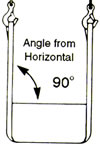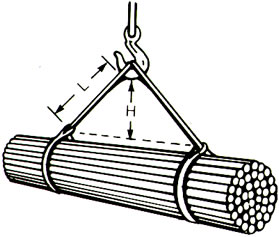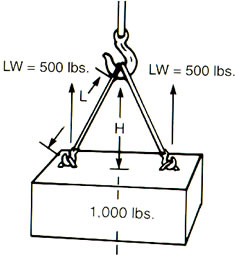Back to Product Category
|
|
 |
|
Order
Online, by Phone, or by E-Mail |
|
|
|
~ Add
items to your online shopping cart ~
Click a Price of the item you wish to purchase. |
|
|
|
|
|
|
|
|
|
|
*Contact
Us For Special Lengths* |
|
|
|
| |
PART
NO. |
Rated
Capacity (lbs.)* |
SLING
THICK.
(IN.) |
SLING
WIDTH
(IN.) |
EYE
LENGTH
(IN.) |
3' |
4' |
6' |
8' |
ADDER/
FT. |
| VERTICAL |
CHOKER |
V.
BASKET |
| ONE
PLY |
RE1-802T |
4,500 |
3,600 |
9,000 |
5/16 |
2 |
9 |
|
|
|
|
$7.40 |
| ONE
PLY |
RE1-804T |
7,700 |
6,200 |
15,400 |
5/16 |
4 |
12 |
|
|
|
|
$12.33 |
| ONE
PLY |
RE1-806T |
11,000 |
8,800 |
22,000 |
5/16 |
6 |
15 |
|
|
|
|
$17.99 |
| TWO
PLY |
RE2-802T |
6,500 |
5,200 |
13,000 |
1/2 |
2 |
9 |
|
|
|
|
$11.08 |
| TWO
PLY |
RE2-804T |
13,000 |
10,400 |
26,000 |
1/2 |
4 |
12 |
|
|
|
|
$17.37 |
| TWO
PLY |
RE2-806T |
20,000 |
16,000 |
40,000 |
1/2 |
6 |
15 |
|
|
|
|
$27.46 |
| THREE
PLY |
RE3-804T |
16,400 |
13,100 |
32,800 |
11/16 |
4 |
14 |
|
|
|
|
$23.62 |
| THREE PLY |
RE3-806T |
25,500 |
20,400 |
51,000 |
11/16 |
6 |
18 |
PRICE ON REQUEST |
* |
Do
not exceed rated capacities. Sling capacity decreases as the angle from
horizontal decreases.
Slings should not be used at angles of less than 30°. Refer to Effect
of Angle chart below. |
|
|
| Effect
of Angle of Lift on a Sling's Rated Capacity |
|
|
|
|
|
|
DEFINITION |
|
|
|
|
|
|
serves
to alert users to potentially hazardous situations which often occur in
the use of these products.
Failure to read, understand and follow the accompanying instructions on
how to avoid these situations
could result in death or serious injury. |
 |
|
|
Using
slings at an angle can become deadly if that angle is not taken into consideration
when selecting the sling to
be used. The tension on each leg of the sling is increased as the angle
of lift, from horizontal, decreases. It is most
desirable for a sling to have a larger angle of lift, approaching 90°.
Lifts with angles of less than 30° from horizontal
are not recommended. If you can measure the angle of lift or the length
and height of the sling as rigged, you can
determine the properly rated sling for your lift. |
|
|
|
|
|
|
|
|
|
|
|
|
|
|
|
|
|
What
would be the rating of each sling
rigged at this angle? |
|
|
 |
|
|
 |
|
What
capacity sling do I need? |
|
|
|
|
|
|
|
|
|
|
|
|
|
|
|
1.
Determine the weight that the sling
will be lifting [LW]. |
|
|
|
|
|
|
|
|
| 1.
Calculate the Reduction Factor [RF]. |
|
|
|
|
|
|
|
|
|
|
|
|
|
|
|
|
|
|
|
a.
Using the angle from horizontal,
read across the Angle Chart to the
corresponding number of the
Reduction Factor column. |
|
|
|
|
|
2.
Calculate the Tension Factor [TF]. |
|
|
|
|
|
|
|
|
|
|
|
|
|
|
|
|
|
|
|
a.
Using the angle from horizontal,
read across the angle chart to the
corresponding number of Tension
Factor column. |
|
|
|
|
|
|
|
|
|
|
|
-OR- |
|
|
|
|
|
|
|
|
|
|
|
|
|
|
|
|
|
|
|
b.
Divide sling height* [H] by sling
length* [L]. |
|
|
|
|
|
|
|
|
|
|
|
|
|
|
|
|
|
|
-OR- |
|
|
|
|
|
|
|
|
|
|
|
|
|
|
|
|
|
|
|
b.
Divide sling height* [H] by sling
length* [L]. |
|
|
|
|
|
Choker
Hitch |
|
Vertical
Hitch |
|
2.
Reduction Factor [RF] x the sling's
rated capacity for the type hitch that
will be used = Sling's Reduced Rating. |
|
|
|
|
|
|
|
|
|
|
|
|
|
|
|
|
|
|
 |
|
|
|
|
|
|
|
|
|
|
|
|
|
|
|
|
|
|
|
|
3.
Lifting Weight [LW] x the Tension
Factor [TF] = Minimum Sling Rating
for the type of hitch that will be used. |
|
|
|
Vertical
Basket
Hitch |
|
|
|
*Measured
from a common horizontal plane to
the hoisting hook. |
|
|
|
|
|
|
|
|
|
|
|
|
|
|
|
*Measured
from a common horizontal
plane to the hoisting hook. |
|
|
|
|
|
|
|
|
|
|
|
|
|
|
|
|
|
|
|
|
|
|
|
|
|
|
|
|
|
|
|
|
Reduced
Capacity |
|
|
|
|
|
|
|
|
|
|
|
Effect
of Angle Chart |
|
Increasing
Tension |
 |
|
|
|
Reduction
Factor |
Angle
From
Horizontal |
Tension
Factor
(TF) |
| 1.000 |
90° |
1.000 |
| 0.996 |
85° |
1.004 |
| 0.985 |
80° |
1.015 |
| 0.966 |
75° |
1.035 |
| 0.940 |
70° |
1.064 |
| 0.906 |
65° |
1.104 |
| 0.866 |
60° |
1.155 |
| 0.819 |
55° |
1.221 |
| 0.766 |
50° |
1.305 |
| 0.707 |
45° |
1.414 |
| 0.643 |
40° |
1.555 |
| 0.574 |
35° |
1.742 |
| 0.500 |
30° |
2.000 |
|
|
 |
Example:
Vertical Choker rating of each sling = 6,000 lbs.
Measured Length (L) = 6 ft.
Measured Height (H) = 4 ft.
Reduction Factor (RF) = 4 (H) ÷ 6 (L) = .667
Reduced sling rating in this configuration = .667
(RF) x 6,000 lbs. = 4,000 lbs. of lifting capacity
per sling |
|
|
|
|
Example:
Load Weight = 1,000 lbs.
Rigging - 2 slings in vertical hitch
Lifting Weight (LW) per sling = 500 lbs.
Measured Length (L) = 10 ft.
Measured Height (H) = 5 ft.
Tension Factor (TF) = 10 (L) ÷ 5 (H) = 2.0
Minimum Vertical Rated Capacity required
for this lift = 500 (LW) x 2.0 (TF) = 1,000
lbs. per sling |
|
Sling
capacity decreases as the angle
from hjorizontal decrease. Sling angles
of less than 30° are not recommended. |
|
|
|
|
|
|
|
|
|
|
|
|
|
|
|
|
|
|
|
|
|
|
|
Reverse Eye Slings, Nylon
Web Sling, Cordura Wear Protection, Endless Sling, Lifting Slings, Lift-All,
Reinforced
Eyes, Red Core Yarn Warning System, Serial Numbered Identification, and
Tuff-Edge from your source for material
handling equipment. |
Back to Product Category
|



